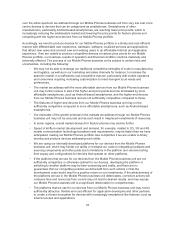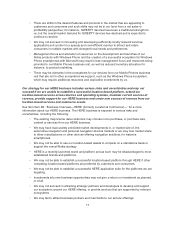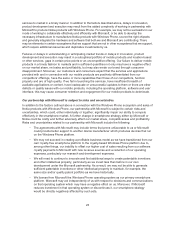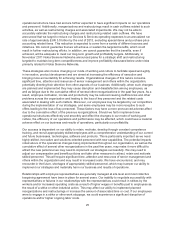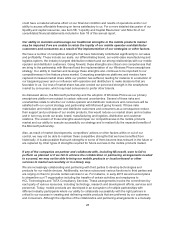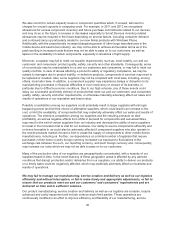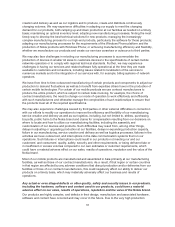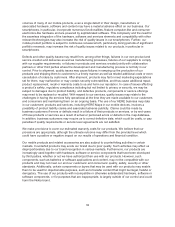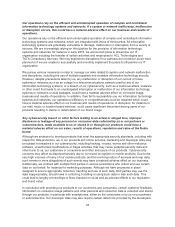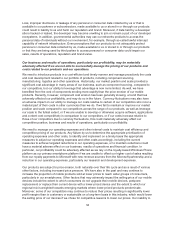Nokia 2012 Annual Report Download - page 26
Download and view the complete annual report
Please find page 26 of the 2012 Nokia annual report below. You can navigate through the pages in the report by either clicking on the pages listed below, or by using the keyword search tool below to find specific information within the annual report.operational structure have had and are further expected to have significant impacts on our operations
and personnel. Additionally, reorganizations and restructurings result in cash outflows related to such
activities, as well as restructuring charges and associated impairments. We may not be able to
accurately estimate the restructuring charges and restructuring related cash outflows. We have
announced that we target to reduce our Devices & Services operating expenses to an annualized run
rate of approximately EUR 3.0 billion by the end of 2013, excluding special items and purchase price
accounting related items. This reduction is expected to come from a variety of different sources and
initiatives. We cannot guarantee that we will achieve or sustain the targeted benefits, which could
result in further restructuring efforts. In addition, we cannot guarantee that the benefits, even if
achieved, will be adequate to meet our long-term growth and profitability targets. Additionally, in
November 2011 Nokia Siemens Networks announced plans for a strategic shift and restructuring
targeted to maintain long-term competitiveness and improve profitability discussed below under risks
primarily related to Nokia Siemens Networks.
These strategies also involve changing our mode of working and culture to facilitate speed and agility
in innovation, product development and are aimed at increasing the efficiency of execution and
bringing more accountability for achieving results. Organizational changes of this nature consume
significant time, attention and resources of senior management and others within the organization,
potentially diverting their attention from other aspects of our business. Additionally, when such changes
are planned and implemented they may cause disruption and dissatisfaction among employees, as
well as fatigue due to the cumulative effect of several other reorganizations in the past few years. As a
result, employee motivation, morale and productivity may be reduced causing inefficiencies and other
problems across the organization and leading to the loss of key personnel and the related costs
associated in dealing with such matters. Moreover, our employees may be targeted by our competitors
during the implementation of our strategies, and some employees may be more receptive to such
offers leading to the loss of key personnel. These factors may have a more pronounced adverse affect
due to the cumulative effect of the previous reorganizations. Should we fail to implement new
operational structures effectively and smoothly and effect the changes in our mode of working and
culture, the efficiency of our operations and performance may be affected, which could have a material
adverse effect on our business and results of operations, particularly our profitability.
Our success is dependent on our ability to retain, motivate, develop through constant competence
training, and recruit appropriately skilled employees with a comprehensive understanding of our current
and future businesses, technologies, software and products. This is particularly important as we need
highly-skilled, innovative and solutions-oriented personnel with new capabilities. The potential impacts
noted above of the operational changes being implemented throughout our organization, as well as the
cumulative effect of several other reorganizations in the past few years, may make it more difficult to
attract the new personnel we may need to implement our strategies successfully. We may need to
adjust our compensation and benefits policies and take other measures to attract, retain and motivate
skilled personnel. This will require significant time, attention and resources of senior management and
others within the organization and may result in increased costs. We have encountered, and may
encounter in the future, shortages of appropriately skilled personnel, which may hamper our ability to
implement our strategies and materially harm our business and results of operations.
Relationships with employee representatives are generally managed at site level and most collective
bargaining agreement have been in place for several years. Our inability to negotiate successfully with
representatives or failures in our relationships with the representatives could result in strikes by the
workers and/or increased operating costs as a result of higher wages or benefits paid to employees as
the result of a strike or other industrial action. This may affect our ability to implement planned
reorganizations and restructurings or increase the amount of associated time or cost. If our employees
were to engage in a strike or other work stoppage, we could experience a significant disruption of
operations and/or higher ongoing labor costs.
25



